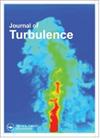瞬态沟道流动中表面粗糙度形貌的影响
IF 1.6
4区 工程技术
Q3 MECHANICS
引用次数: 4
摘要
采用直接数值模拟的方法,研究了粗糙度几何对半高湍流通道对脉冲加速度响应的动力学影响。在表面高度谱上不同的两个粗糙表面之间进行了比较,并与光滑壁基线情况进行了比较。两种粗糙情况都是从过渡粗糙状态发展到完全粗糙状态。结果表明,在粗糙壁面上,粗糙度亚层(RSL)的厚度几乎保持不变,即具有显著的形状诱导应力的层。在整个瞬态过程中,RSL内部的总体平均流保持在接近平衡状态。形式引起的扰动在很大程度上与RSL边缘的平均速度成比例,表明了这一点。在RSL内部,湍流迅速发展到新的稳定状态,伴随着雷诺应力平衡的实质性变化。相比之下,在亚层完全发育后很长一段时间内,RSL上方的流动恢复,雷诺应力平衡没有明显变化。粗糙度的几何形状在决定整个边界层湍流的响应速率方面起着重要作用。这项工作提供了表面粗糙度在响应平均流动加速度时抑制反向转变的详细解释。本文章由计算机程序翻译,如有差异,请以英文原文为准。
Effects of surface roughness topography in transient channel flows
The dynamical effects of roughness geometry on the response of a half-height turbulent channel flow to an impulse acceleration are investigated using direct numerical simulations. Two rough surfaces different in the surface height spectrum are compared between themselves and with a smooth-wall baseline case. Both rough cases develop from a transitionally rough state to a fully rough one. Results show that on rough walls the thickness of the roughness sublayer (RSL), defined as the layer with significant form-induced stresses, stays almost constant. The ensemble-average flows inside the RSL stays close to equilibrium throughout the transient. This is shown by the form-induced perturbations largely scaling with the mean velocity at the edge of the RSL. Inside the RSL, turbulence develops rapidly to the new steady state, accompanied by substantial changes in the Reynolds stress balance. In contrast, the flow above the RSL recovers long after the sublayer is fully developed, without a significant change in Reynolds stress balance. The geometry of the roughness plays an important role in determining the rate of response of turbulence throughout the boundary layer. This work provides detailed explanation of the suppression of reverse transition by surface roughness in response to a mean flow acceleration.
求助全文
通过发布文献求助,成功后即可免费获取论文全文。
去求助
来源期刊

Journal of Turbulence
物理-力学
CiteScore
3.90
自引率
5.30%
发文量
23
审稿时长
6-12 weeks
期刊介绍:
Turbulence is a physical phenomenon occurring in most fluid flows, and is a major research topic at the cutting edge of science and technology. Journal of Turbulence ( JoT) is a digital forum for disseminating new theoretical, numerical and experimental knowledge aimed at understanding, predicting and controlling fluid turbulence.
JoT provides a common venue for communicating advances of fundamental and applied character across the many disciplines in which turbulence plays a vital role. Examples include turbulence arising in engineering fluid dynamics (aerodynamics and hydrodynamics, particulate and multi-phase flows, acoustics, hydraulics, combustion, aeroelasticity, transitional flows, turbo-machinery, heat transfer), geophysical fluid dynamics (environmental flows, oceanography, meteorology), in physics (magnetohydrodynamics and fusion, astrophysics, cryogenic and quantum fluids), and mathematics (turbulence from PDE’s, model systems). The multimedia capabilities offered by this electronic journal (including free colour images and video movies), provide a unique opportunity for disseminating turbulence research in visually impressive ways.
 求助内容:
求助内容: 应助结果提醒方式:
应助结果提醒方式:


